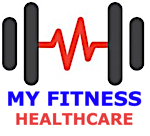Fact Checked
Evidence Based
Most experts consider the back squat the “king of exercises.”
It gets this moniker because it’s perhaps the single best exercise for developing every major muscle group in your body.
That’s only true if you do it correctly, though. Fortunately, that’s precisely what you’ll learn in this article.
What Is the Barbell Back Squat?
The barbell back squat (or “BB back squat”) is a leg exercise that involves squatting with a barbell across your upper back.
There are two ways to position the bar on your back while you squat:
- The high-bar position, where the bar rests on your upper traps
- The low-bar position, where the bar rests between the mid traps and rear deltoids
Here’s how they look:
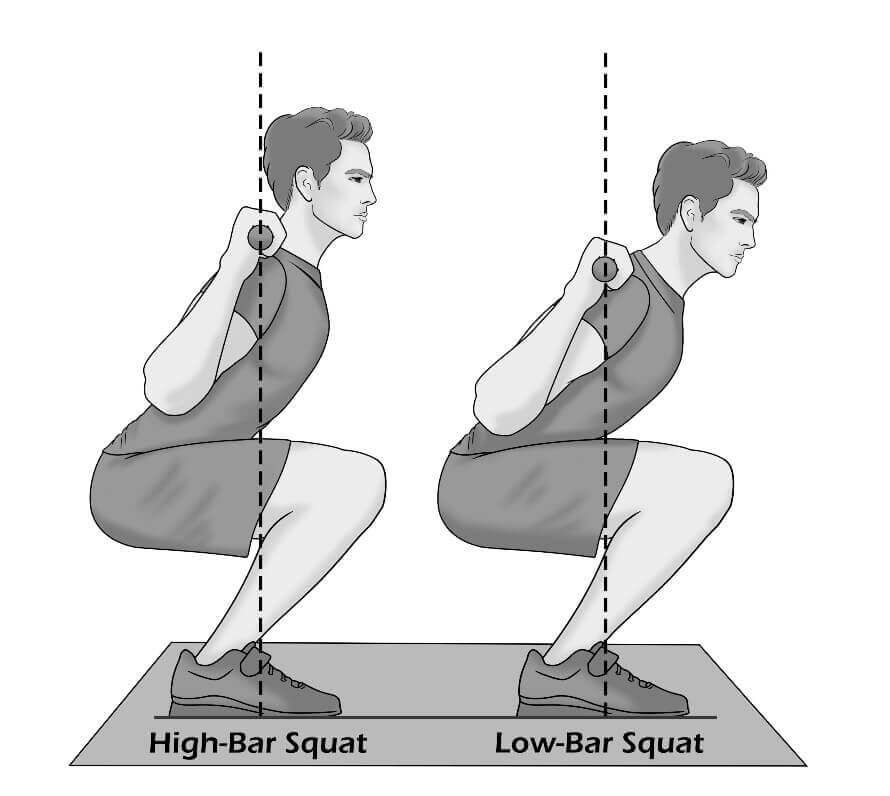
Because the low-bar back squat allows you to leverage your large leg muscles better and lift more weight, I recommend beginners start with the low-bar variation. As such, that’s the squat variation we’ll focus on in this article (and the version I recommend in my fitness books for men and women, Bigger Leaner Stronger or Thinner Leaner Stronger).
However, if you find the low-bar squat uncomfortable on your shoulders and wrists, the high-bar squat is a perfectly viable alternative.
Back Squat: Benefits
1. It trains several major muscle groups.
While the back squat with a barbell is primarily a leg exercise, many also consider it a full-body exercise because it trains almost every major muscle group in your body.
Specifically, the main muscles worked by the back squat are the quadriceps, glutes, erector spinae, latissimus dorsi, trapezius, calves, and abs.
2. It improves athletic performance.
The back squat improves your athletic performance in three ways:
- It helps you develop lower-body power, speed, and strength.
- It trains “hip extension” (moving your thighs away from your upper body), which improves your performance in sports that involve running, jumping, climbing, and so forth.
- It helps you build lower-body stability, making you less prone to injury, so you can spend more time competing and less on the sidelines.
3. It allows you to lift heavy weights.
The back squat lets you lift heavier weights than most other exercises and activates more muscle groups across your entire body, making it fantastic for building muscle and strength and burning fat.
It also allows you to progress regularly, which is the best way to maximize the muscle- and strength-building, and fat-burning benefits of weightlifting.
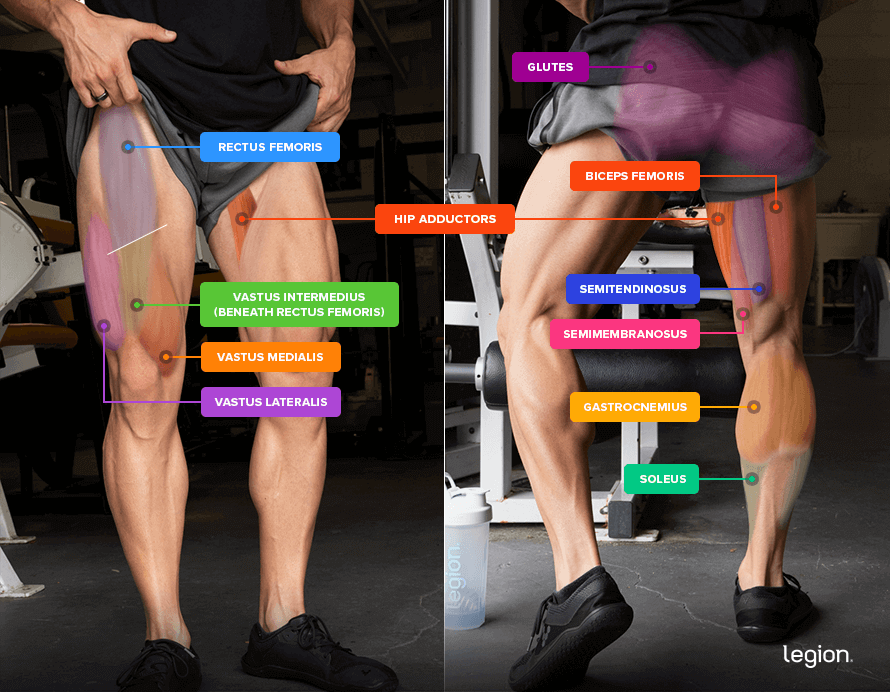
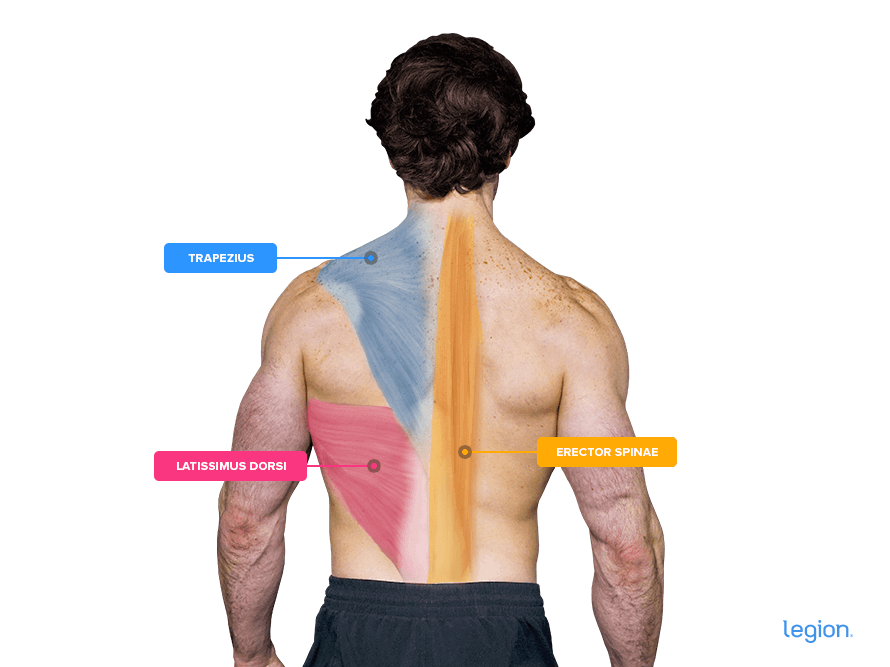
Back Squat: Form
The best way to learn how to back barbell squat is to split the exercise into three parts: set up, descend, and squat.
Step 1: Set Up
Adjust the hooks in a squat rack so the bar is at the height of your midchest like this:
Overhead-press-vs-military-press.png
If your squat rack has safety arms or bars, set them to about the height of your midthigh. Load the bar with your desired amount of weight (or not, if the bar alone is enough).
Grip the bar with your palms facing forward and your hands about 4-to-8 inches wider than shoulder-width apart.
Place your feet underneath the bar a little wider than shoulder-width apart. Then, push your torso under and up against the bottom of the bar so it rests against the back of your shoulders.
Pull your shoulder blades together and down to create a little “shelf” out of the bony protrusions of your shoulder blades, and then maneuver your torso so the bar nestles into this shelf.
Unrack the bar by standing up and taking one step back with each foot (one at a time). Adjust your squat stance so that your feet are a little wider than shoulder-width apart, and point your toes out about 20-to-25 degrees (around one and eleven o’clock).
Here’s what you should look like from the front and back:

Step 2: Descend
Take a deep breath into your stomach, keep your torso upright, push your chest out, brace your core, then push your hips back and bend your knees simultaneously. Keep sitting down until your thighs are parallel to the floor or slightly lower.
If you find back squatting with a full range of motion challenging, use the stretches in this article to improve your hip and ankle mobility and perform squat variations that allow you to more easily squat deeply (e.g., Bulgarian split squat, front squat, and goblet squat) until your flexibility improves.
Squatting in squat shoes with a raised heel can also help. However, I don’t recommend elevating your heels on weight plates as this is unstable and can increase your risk of injury.
Here’s how you should look at the bottom of the back squat:
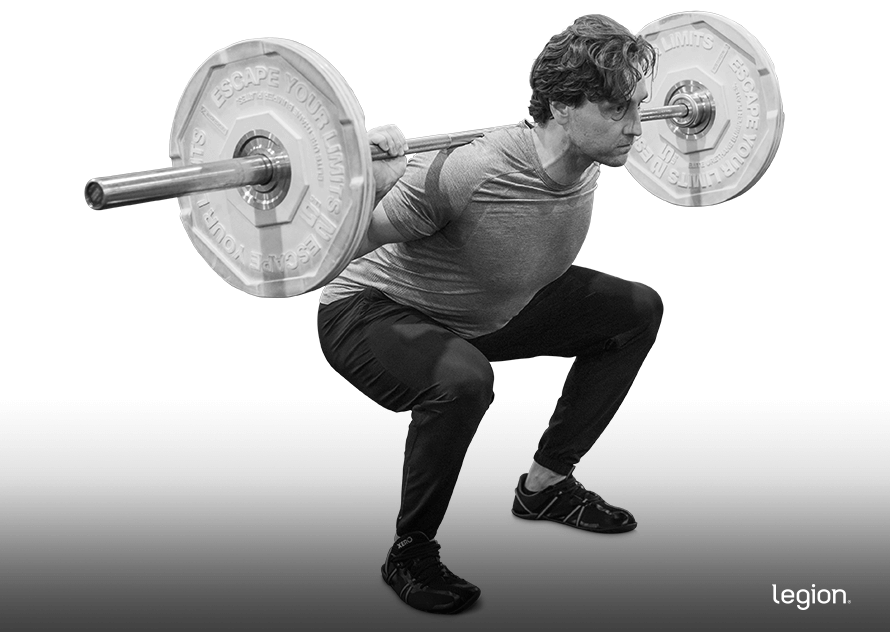
Step 3: Squat
Drive your feet into the floor, ensuring your shoulders move upward at the same rate as your hips—a mirror image of what you did during the descent. About halfway up, push your hips forward and underneath the bar to return to the starting position.
Here’s how it should look when you put it all together:
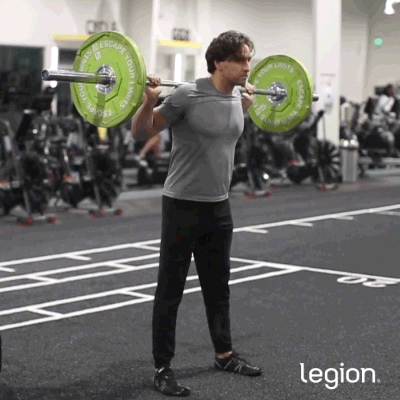
+ Scientific References
- Watford, Malcolm, and Guoyao Wu. “Protein.” Advances in Nutrition, vol. 9, no. 5, 27 July 2018, pp. 651–653, www.ncbi.nlm.nih.gov/pmc/articles/PMC6140426/, https://doi.org/10.1093/advances/nmy027.
- Rizzoli, R., et al. “Benefits and Safety of Dietary Protein for Bone Health—an Expert Consensus Paper Endorsed by the European Society for Clinical and Economical Aspects of Osteopororosis, Osteoarthritis, and Musculoskeletal Diseases and by the International Osteoporosis Foundation.” Osteoporosis International, vol. 29, no. 9, 8 May 2018, pp. 1933–1948, https://doi.org/10.1007/s00198-018-4534-5.
- Li, Peng, et al. “Amino Acids and Immune Function.” British Journal of Nutrition, vol. 98, no. 02, 3 Apr. 2007, p. 237, www.cambridge.org/core/journals/british-journal-of-nutrition/article/amino-acids-and-immune-function/B1A9C1587A8602613F6447BA8404D8E1, https://doi.org/10.1017/s000711450769936x.
- Wang, Xue, et al. “The Effect of a Compound Protein on Wound Healing and Nutritional Status.” Evidence-Based Complementary and Alternative Medicine, vol. 2022, no. 10.1155/2022/4231516, 24 Mar. 2022, p. e4231516, www.hindawi.com/journals/ecam/2022/4231516/, https://doi.org/10.1155/2022/4231516.
- Phillips, Stuart M., and Luc J.C. Van Loon. “Dietary Protein for Athletes: From Requirements to Optimum Adaptation.” Journal of Sports Sciences, vol. 29, no. sup1, Jan. 2011, pp. S29–S38, www.tandfonline.com/doi/full/10.1080/02640414.2011.619204, https://doi.org/10.1080/02640414.2011.619204.
- Hector, Amy J., and Stuart M. Phillips. “Protein Recommendations for Weight Loss in Elite Athletes: A Focus on Body Composition and Performance.” International Journal of Sport Nutrition and Exercise Metabolism, vol. 28, no. 2, Mar. 2018, pp. 170–177, https://doi.org/10.1123/ijsnem.2017-0273.
- Helms, Eric R., et al. “A Systematic Review of Dietary Protein during Caloric Restriction in Resistance Trained Lean Athletes: A Case for Higher Intakes.” International Journal of Sport Nutrition and Exercise Metabolism, vol. 24, no. 2, Apr. 2014, pp. 127–138, https://doi.org/10.1123/ijsnem.2013-0054.
- Morton, Robert W, et al. “A Systematic Review, Meta-Analysis and Meta-Regression of the Effect of Protein Supplementation on Resistance Training-Induced Gains in Muscle Mass and Strength in Healthy Adults.” British Journal of Sports Medicine, vol. 52, no. 6, 11 July 2017, pp. 376–384, bjsm.bmj.com/content/52/6/376.abstract, https://doi.org/10.1136/bjsports-2017-097608.
- Layman, Donald K., et al. “Dietary Protein and Exercise Have Additive Effects on Body Composition during Weight Loss in Adult Women.” The Journal of Nutrition, vol. 135, no. 8, 1 Aug. 2005, pp. 1903–1910, https://doi.org/10.1093/jn/135.8.1903. Accessed 6 Mar. 2019.
- Longland, Thomas M, et al. “Higher Compared with Lower Dietary Protein during an Energy Deficit Combined with Intense Exercise Promotes Greater Lean Mass Gain and Fat Mass Loss: A Randomized Trial.” The American Journal of Clinical Nutrition, vol. 103, no. 3, 27 Jan. 2016, pp. 738–746, academic.oup.com/ajcn/article/103/3/738/4564609, https://doi.org/10.3945/ajcn.115.119339.
- Roberts, Brandon M, et al. “Nutritional Recommendations for Physique Athletes.” Journal of Human Kinetics, vol. 71, no. 1, 31 Jan. 2020, pp. 79–108, www.ncbi.nlm.nih.gov/pmc/articles/PMC7052702/, https://doi.org/10.2478/hukin-2019-0096.
- Mettler, Samuel . Increased Protein Intake Reduces Lean Body Mass Loss during Weight Loss in Athletes. Nov. 2009, pp. 42(2):326-37, https://doi.org/10.1249/MSS.0b013e3181b2ef8e.
- Helms, Eric R., et al. “High-Protein, Low-Fat, Short-Term Diet Results in Less Stress and Fatigue than Moderate-Protein, Moderate-Fat Diet during Weight Loss in Male Weightlifters: A Pilot Study.” International Journal of Sport Nutrition and Exercise Metabolism, vol. 25, no. 2, Apr. 2015, pp. 163–170, https://doi.org/10.1123/ijsnem.2014-0056.
- Walberg, J., et al. “Macronutrient Content of a Hypoenergy Diet Affects Nitrogen Retention and Muscle Function in Weight Lifters.” International Journal of Sports Medicine, vol. 09, no. 04, Aug. 1988, pp. 261–266, https://doi.org/10.1055/s-2007-1025018.
- Helms, Eric R., et al. “High-Protein, Low-Fat, Short-Term Diet Results in Less Stress and Fatigue than Moderate-Protein, Moderate-Fat Diet during Weight Loss in Male Weightlifters: A Pilot Study.” International Journal of Sport Nutrition and Exercise Metabolism, vol. 25, no. 2, Apr. 2015, pp. 163–170, https://doi.org/10.1123/ijsnem.2014-0056.
- Sardeli, Amanda, et al. “Resistance Training Prevents Muscle Loss Induced by Caloric Restriction in Obese Elderly Individuals: A Systematic Review and Meta-Analysis.” Nutrients, vol. 10, no. 4, 29 Mar. 2018, p. 423, https://doi.org/10.3390/nu10040423.
- Miller, Todd, et al. “Resistance Training Combined with Diet Decreases Body Fat While Preserving Lean Mass Independent of Resting Metabolic Rate: A Randomized Trial.” International Journal of Sport Nutrition and Exercise Metabolism, vol. 28, no. 1, Jan. 2018, pp. 46–54, https://doi.org/10.1123/ijsnem.2017-0221.
You May Also Like
Our Most Popular Evidence-Based Articles
You don’t need supplements to build muscle, lose fat, and get healthy. But the right ones can help.
Take our 60-second quiz now to learn which supplements can help you achieve your fitness goals faster.
Sending…
Your free stuff is on the way!
Follow the Diet Plan that Helped Nikita Lose 15 Pounds in 3 Months
“I never thought getting in shape would be this simple! Everything just WORKS when you follow this plan.” And if he can do it, why not you?

Wait!
Want a Free Custom Meal Planning Tool?
Quickly calculate your calories, macros, and micros for losing fat, building muscle, and staying healthy.
Our “No Return Necessary”
Money-Back Guarantee
If you don’t like something of ours, guess what happens next?
No, we don’t request you deliver it to a PO box in the Gobi Desert by carrier pigeon. Nor do we ask you to fill a cursed inkwell with orc’s blood and demon saliva and then use it to complete reams of return forms written in ancient Cyrillic script.
We just . . . wait for it . . . give you your money back. Holy moo cows. And that means you can say “yes” now and decide later.
Free Worldwide Shipping & Returns
Many companies use shipping and handling fees to increase their profit margins, but here at Legion, we hate profits, so our shipping is free!
Okay, so we do dig on profits, but we also go in for happy customers, and free shipping works like gangbusters. So, if you live in the United States, your order ships free regardless of order size, if you live in the UK or Canada, your order ships free when it’s over $99, and if you live elsewhere, your order ships free when it’s over $199.
Also, if you don’t absolutely love our stuff for whatever reason, we don’t request you deliver it to a PO box in the Gobi Desert by carrier pigeon.
We just . . . wait for it . . . give you your money back. No returns. No forms. No nonsense. Holy moo cows.
That means you can say “yes” now and decide later. You really have nothing to lose.
Free Worldwide Shipping & Returns
Many companies use shipping and handling fees to increase their profit margins, but here at Legion, we hate profits, so our shipping is free!
Okay, so we do dig on profits, but we also go in for happy customers, and free shipping works like gangbusters. So, if you live in the UK or Canada, your order ships free when it’s over $99.
Why the restriction on international orders? Unfortunately, shipping abroad is very expensive, and if we didn’t require a minimum order size, we’d lose a lot of money. But! We’re also hustling to improve our international logistics and will be passing our savings along to our international customers.
Also, if you don’t absolutely love our stuff for whatever reason, we don’t request you deliver it to a PO box in the Gobi Desert by carrier pigeon.
We just . . . wait for it . . . give you your money back. No returns. No forms. No nonsense. Holy moo cows.
That means you can say “yes” now and decide later. You really have nothing to lose.
Free Worldwide Shipping & Returns
Many companies use shipping and handling fees to increase their profit margins, but here at Legion, we hate profits, so our shipping is free!
Okay, so we do dig on profits, but we also go in for happy customers, and free shipping works like gangbusters. So, if you’re outside the USA, your order ships free when it’s over $199.
Why the restriction on international orders? Unfortunately, shipping abroad is very expensive, and if we didn’t require a minimum order size, we’d lose a lot of money. But! We’re also hustling to improve our international logistics and will be passing our savings along to our international customers.
Also, if you don’t absolutely love our stuff for whatever reason, we don’t request you deliver it to a PO box in the Gobi Desert by carrier pigeon.
We just . . . wait for it . . . give you your money back. No returns. No forms. No nonsense. Holy moo cows.
That means you can say “yes” now and decide later. You really have nothing to lose.
Clinically Effective Ingredients & Doses
Many ingredients in supplements don’t have any scientifically validated benefits, and many ingredients that do are often underdosed to the point of irrelevance.
That’s why we only use the choice ingredients and precise doses shown to be effective in peer-reviewed scientific studies.
Clinically Effective Doses
You need more than great ingredients to make great products—you also need proper doses. That’s why we use the precise doses of ingredients shown to be effective in peer-reviewed scientific studies.
100% Natural Ingredients
“Natural” doesn’t always mean “better,” but in many cases, natural ingredients are superior to artificial ones for various reasons, including purity, safety, and efficacy.
That’s why all of our ingredients in all of our products come from plant and animal sources, including sweeteners, colors, and flavors.
Made in USA
If you want to ensure the supplements you’re swallowing every day are safe and effective, you want products produced in the USA.
That’s why all of our supplements are made in America in NSF-certified and FDA-inspected facilities that operate in accordance with the Current Good Manufacturing Practice (cGMP) regulations.
Lab Tested
Did you know that supplements can contain dangerously high levels of toxins like lead, arsenic, and cadmium?
That’s why we test every ingredient of every supplement we produce for heavy metals, microbes, allergens, and other contaminants and ensure they meet the strict purity standards set by the FDA.
Naturally Sweetened & Flavored
While artificial sweeteners may not be as dangerous as some people claim, studies suggest that regular consumption of these chemicals may indeed be harmful to our health.
That’s why all of our supplements are naturally sweetened and flavored and contain no artificial food dyes, fillers, or other unnecessary junk.
Science-Backed Ingredients
Many ingredients in supplements don’t have any scientifically validated benefits. That’s why we only use choice ingredients shown to be effective in peer-reviewed scientific studies.
No Chemical Junk
“Natural” doesn’t always mean “better,” but in many cases, natural ingredients are superior to artificial ones for various reasons, including purity, safety, and efficacy.
That’s why all of our ingredients in all of our products come from plant and animal sources, including sweeteners, colors, and flavors.




Split your entire online purchase into 4 interest-free payments, over 6 weeks with no impact to your credit.

25%
today
25%
2 weeks
25%
4 weeks
25%
6 weeks

Shop and add items to your cart as normal!

Choose Sezzle at Checkout! You’ll be redirected to Sezzle to Sign Up or Log In
to complete your order.

Your order will be shipped out right away* and your payments will be split up
over 6 weeks.
*shipping times subject to merchant shipping policy
Shop directory. Reschedule payments. Plus more!
Waiver and Release of Liability
In consideration of the services and/or products offered by Legion Athletics, Inc. (“Legion”) including, but not limited to, nutrition plans, exercise routines and coaching, and in addition to the payment of any fee or charge:
I knowingly and voluntarily enter into this waiver and release of liability and hereby waive any and all rights, claims or causes of action of any kind whatsoever arising out of my use of Legion’s services and/or products, and I hereby release and hold harmless Legion and its consultants, officers, contractors, agents, owners and employees from any and all responsibility, liability, cost and expenses, including for injuries, damages or disorders (physical, metabolic, or otherwise), resulting from my use of Legion’s services and/or products.
I understand that fitness activities including, but not limited to, strength, flexibility, and cardiovascular exercise, with or without the use of equipment, are potentially hazardous activities that involve a risk of injury and even death, and I am voluntarily participating in these activities and using equipment and machinery with knowledge of the risks involved. I hereby agree to assume and accept any and all risks of injury or death related to said fitness activities.
I understand Legion’s services and products are not meant to treat or manage any health conditions or circumstances, and I acknowledge that Legion has recommended I obtain a healthcare provider’s approval for my use of Legion’s services and/or products, through regular physical examination(s) and/or consultation. I acknowledge that I have obtained my healthcare provider’s approval or have decided to use Legion’s services and/or products without such approval and hereby assume all responsibility for my use of said services and/or products.
I understand that results from using Legion’s products and/or services are not guaranteed, and I agree to not hold Legion liable for any outcomes or lack thereof.
OUT OF STOCK
Security Check
Please click the checkbox below. We apologize for the inconvenience.
If you don’t absolutely love this product, just let us know, and we’ll give you a full refund on the spot. No forms or return necessary.
Analyzed for purity and potency in a state-of-the-art ISO 17025 accredited lab by Labdoor™, the gold standard of third-party lab testing.
Analyzed for purity and potency in a state-of-the-art ISO 17025 accredited lab, the gold standard of third-party lab testing.
This product doesn’t just “contain natural ingredients’’—every ingredient is naturally sourced from plants and animals. This product contains no artificial or synthetic substances of any kind.
Fact Checked
Our scientific review board of nutritionists, dietitians, molecular biologists, doctors, and other accredited experts is responsible for reviewing every article, podcast, and video we produce to ensure they’re evidence based, accurate, trustworthy, and current.
Thanks to their connections, credentials, and academic experience, this team of MDs, PhDs, and other professionals has access to a wealth of research published in the largest and most prestigious journals in the world.
This allows them to not only review individual studies but also analyze the overall weight of the evidence on any and all topics related to diet, exercise, supplementation, and more.
If you feel that any of our content is inaccurate, misleading, out-of-date, or anything less than factual, please let us know in the comments section of the article in question.
Evidence Based
We follow a detailed, rigorous, multi-step process to create content that meets the highest standards of clarity, practicality, and scientific integrity.
First, our research associates provide our editorial team with accurate, up-to-date, proven scientific evidence.
Then, our editorial team uses this research to draft articles and outlines for podcasts and videos.
Finally, our scientific review board reviews the content to ensure all key information and claims are backed by high-quality scientific research and explained simply and precisely.
If you feel that any of our content is inaccurate, misleading, out-of-date, or anything less than factual, please let us know in the comments section of the article in question.
